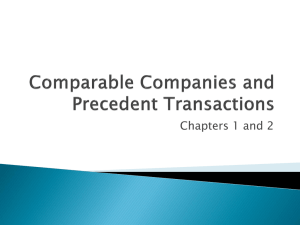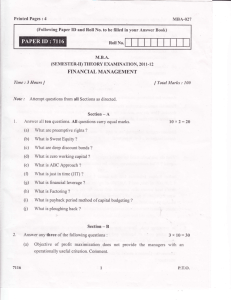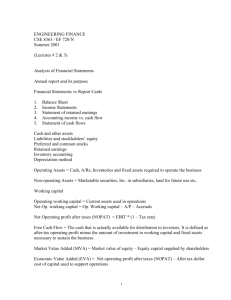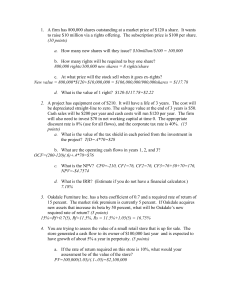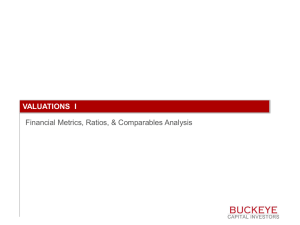Chapter 6 Comparable Companies Analysis
advertisement
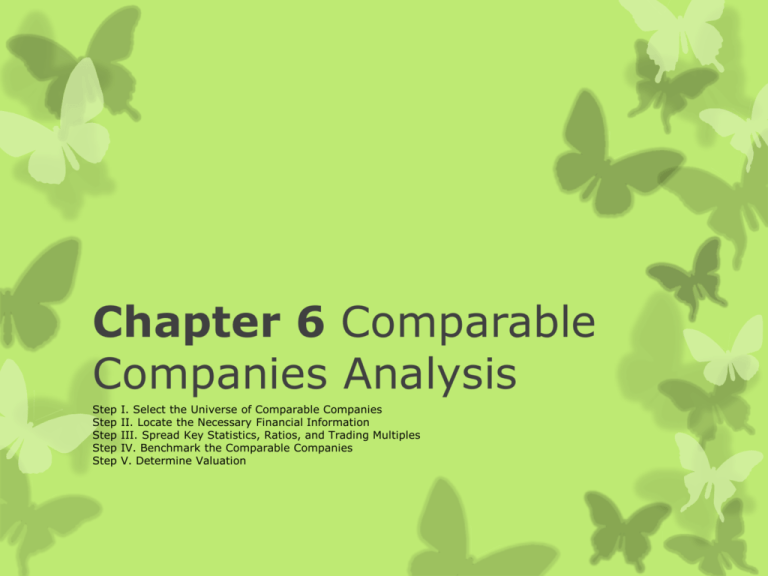
Chapter 6 Comparable Companies Analysis Step Step Step Step Step I. Select the Universe of Comparable Companies II. Locate the Necessary Financial Information III. Spread Key Statistics, Ratios, and Trading Multiples IV. Benchmark the Comparable Companies V. Determine Valuation Comparable companies analysis • • Comparable companies analysis (“comparable companies” or “trading comps”) is one of the primary methodologies used for valuing a given focus company, division, business, or collection of assets (“target”). Comparable companies has a broad range of applications, most notably for various mergers & acquisitions (M&A) situations, initial public offerings (IPOs), restructurings, and investment decisions. The foundation for trading comps The foundation for trading comps is built upon the premise that similar companies provide a highly relevant reference point for valuing a given target due to the fact that they share key business and financial characteristics, performance drivers, and risks. Step I. Select the Universe of Comparable Companies. The selection of a universe of comparable companies for the target is the foundation for performing trading comps. While this exercise can be fairly simple and intuitive for companies in certain sectors, it can prove challenging for others whose peers are not readily apparent. Companies in the same sector (or, preferably, “subsector”) with similar size tend to serve as good comparables. Study the Target • • Identify Key Characteristics of the Target for Comparison Purposes 1.3 Business and Financial Profile Framework • • • • • Sector Products and Services Customers and End Markets Distribution Channels Geography • • • • • Size Profitability Growth Profile Return on Investment Credit Profile • Business Profile • Financial Profile Business Profile Business Profile Sector Products and Services Customers and End Markets Distribution Channels Geography Sector Sector refers to the industry or markets in which a company operates (e.g., chemicals, consumer products, healthcare, industrials, and technology). • A company’s sector can be further divided into subsectors, which facilitates the identification of the target’s closest comparable. • Products and Services A company’s products and services are at the core of its business model. Accordingly,companies that produce similar products or provide similar services typically serve as good comparables. Customers and End Markets Customers refer to the purchasers of its products and services. Companies with a similar customer base tend to share similar opportunities and risks. End markets refer to the broad underlying markets into which it sells its products and services. companies that sell products and services into the same end markets generally share a similar performance outlook, which is important for determining appropriate comparable companies. Distribution Channels Distribution channels are the avenues through which a company sells its products and services to the end user. Geography Companies that are based in (and sell to) different regions of the world often differ substantially in terms of fundamental business drivers and characteristics. The differences in growth rates, macro- economic environment, competitive dynamics, path(s)- to-market, organizational and cost structure, and potential opportunities and risks. Financial Profile Size Size is typically measured in terms of market valuation (e.g., equity value and enterprise value), as well as key financial statistics (e.g., sales, gross profit, EBITDA, EBIT, and net income). Companies of similar size in a given sector are more likely to have similar multiples than companies with significant size discrepancies. Consequently, differences in size often map to differences in valuation. profitability A company’s profitability measures its ability to convert sales into profit. Profitability ratios (“margins”) employ a measure of profit in the numerator, such as gross profit, EBITDA, EBIT, or net income, and sales in the denominator. Growth Profile A company’s growth profile, as determined by its historical and estimated future financial performance, is an important driver of valuation. Return on Investment Return on investment (ROI) measures a company’s ability to provide earnings (or returns) to its capital providers. credit profile A company’s credit profile refers to its creditworthiness as a borrower. It is typically measured by metrics relating to a company’s overall debt level (“leverage”) as well as its ability to make interest payments (“coverage”), and reflects key companyand sectorspecific benefits and risks. Screen for Comparable Companies At the initial stage, the focus is on identifying companies with a similar business profile. While basic financial information (e.g., sales, enterprise value, or equity value) should be assessed early on, more detailed financial benchmarking is performed in Step IV. Investment banks generally have established lists of comparable companies by sector containing relevant multiples and other financial data, which are updated on a quarterly basis and for appropriate company-specific actions. an examination of the target’s public competitors is usually the best place to begin. An additional source for locating comparables is the proxy statement for a relatively recent M&A transaction in the sector (“merger proxy”), as it contains excerpts from a fairness opinion. The banker may also screen for companies that operate in the target’s sector using SIC or NAICS codes Standard Industrial Classification (SIC) is a system established by the U.S. government for classifying the major business operations of a company with a numeric code. North American Industry Classification System (NAICS) codes in lieu of SIC codes. The SEC, however, still uses SIC codes. In addition to the aforementioned, senior bankers are perhaps the most valuable resources for determining the comparables universe. STEP II. LOCATE THE NECESSARY FINANCIAL INFORMATION SEC Filings: 10-K, 10-Q, 8-K, and Proxy Statement 10-K (Annual Report); 10-Q (Quarterly Report); 8-K (Current Report). Proxy Statement A proxy statement is a document that a public company sends to its shareholders prior to a shareholder meeting containing material information regarding matters on which the shareholders are expected to vote. Equity Research Research Reports Equity research reports provide individual analyst estimates of future company performance, which may be used to calculate forwardlooking multiples. They generally include estimates of sales, EBITDA and/or EBIT, and EPS for future quarters and the future two- or three-year period (on an annual basis). Equity research reports often provide commentary on non-recurring items and recentM&Aand capital markets transactions, which are helpful for determining pro forma adjustments and normalizing financial data. Consensus Estimates Consensus research estimates for selected financial statistics are widely used by bankers as the basis for calculating forward-looking trading multiples in trading comps. Consensus estimates are First Call and IBES, which can be located through Bloomberg, FactSet, and Thomson Reuters, among other financial information services. Press Releases and News Runs Financial Information Services A company issues a press release when it has something important to report to the public. STEP III. SPREAD KEY STATISTICS, RATIOS, AND TRADING MULTIPLES Calculation of Key Financial Statistics and Ratios Size (Market Valuation: equity value and enterprise value; and Key Financial Data: sales, gross profit, EBITDA, EBIT, and net income) Profitability (gross profit, EBITDA, EBIT, and net income margins) Growth Profile (historical and estimated growth rates) Return on Investment (ROIC, ROE, ROA, and dividend yield) Credit Profile (leverage ratios, coverage ratios, and credit ratings) Growth Profile (historical and estimated growth rates) Return on Investment (ROIC, ROE, ROA, and dividend yield) Credit Profile (leverage ratios, coverage ratios, and credit ratings) Size: Market Valuation Equity Value Equity value (“market capitalization”) is the value represented by a given company’s basic shares outstanding plus “in-themoney” stock options,29 warrants, 30 and convertible securities—collectively, “fully diluted shares outstanding.” Size Equity Value Calculation of Fully Diluted Shares Outstanding Basic shares outstanding The incremental shares represented by a company’s inthe-money options and warrants are calculated in accordance with the treasury stock method (TSM). Options and Warrants—The Treasury Stock Method The TSM assumes that all tranches of in-the-money options and warrants are exercised at their weighted average strike price with the resulting option proceeds used to repurchase outstanding shares of stock at the company’s current share price. Example Convertible and Equity-Linked Securities Outstanding convertible and equity linked securities also need to be factored into the calculation of fully diluted shares outstanding. If-Converted Method Net Share Settlement If-Converted Method when performing trading comps, in-the-money converts are converted into additional shares by dividing the convert’s amount outstanding by its conversion price. Net Share Settlement For converts issued with a net share settlement accounting feature, the issuer is permitted to satisfy the face (or accreted) value of an in-the-money convert with cash upon conversion. . Only the value represented by the excess of the current share price over the conversion price is assumed to be settled with the issuance of additional shares, which results in less share issuance. This serves to limit the dilutive effects of conversion by affording the issuer TSM accounting treatment Enterprise Value Enterprise value (“total enterprise value” or “firm value”) is the sum of all ownership interests in a company and claims on its assets from both debt and equity holders.
